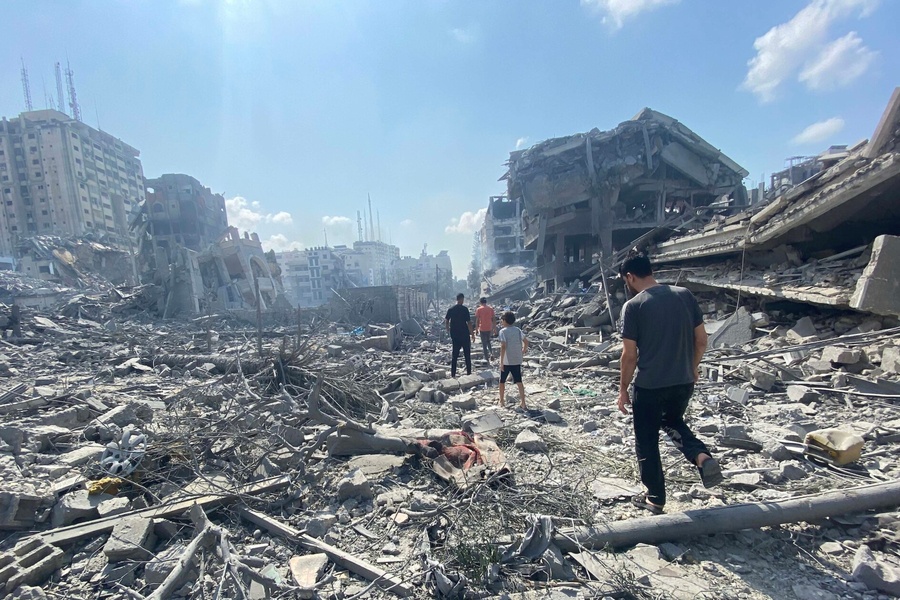Legal Considerations Guiding the Iraq-Kurdistan Dispute
Three weeks ago, a U.S.-led coalition made up of Iraqi military units, Kurdish Peshmerga, Sunni tribal groups and Iran-backed Shiite militias began the campaign to liberate Mosul from ISIL control. Home to as many as 1.5 million Iraqis, Mosul is the country’s second largest city and represents ISIL’s last major Iraqi stronghold.
Published by The Lawfare Institute
in Cooperation With

Three weeks ago, a U.S.-led coalition made up of Iraqi military units, Kurdish Peshmerga, Sunni tribal groups and Iran-backed Shiite militias began the campaign to liberate Mosul from ISIL control. Home to as many as 1.5 million Iraqis, Mosul is the country’s second largest city and represents ISIL’s last major Iraqi stronghold. After successive ISIL defeats in Tikrit, Fallujah, Ramadi, and Kirkuk, the outcome of the battle for Mosul appears to be certain—a hard-won victory for the coalition is a question of when, not if. What’s less certain, however, is who will control Mosul and other territory in dispute between Iraq’s federal government and the Kurdistan Regional Government (KRG) once ISIL is dislodged.
One hundred years after the Sykes-Picot Agreement divided portions of the Ottoman Empire into British and French mandates, the state of Iraq is no more unified than it was when the European diplomats put pen and ruler to paper. Calls for partition of the country between Sunni Arabs, Shia Arabs, and Kurds are familiar, and Kurds (concentrated near the country’s northern border with Turkey, Syria, and Iran) have sought independence in their homeland for upwards of a century.
Yet the boundaries of Kurdish territory in Iraq remain in dispute: The Kurds’ territorial claims exceed the borders of the three provinces recognized by Iraq’s federal government as comprising Kurdistan, yet most of the disputed areas are currently under Kurdish control, thanks to the Peshmerga’s skillful retaking of the territory ceded to ISIL by a retreating Iraqi Army. The Kurds’ claims historically include the oil-rich province of Kirkuk, but do not include Mosul, though Kurdish gains there in the current campaign against ISIL could be used as leverage in future negotiations with Baghdad. Aside from the disputed territory’s historical significance, it is important for another reason: Kurdistan sits atop massive oil deposits, an estimated three percent of global proven reserves. Despite depressed prices, oil still means money, money means power, and power in the hands of the KRG could mean independence.
The resolution of the dispute between Iraq and Kurdistan is as likely to be guided by political considerations as by legal ones, but the present legal regime does shed light on the dynamics at play and the KRG’s chances of breaking free. Here’s how.
- Iraq’s Federal Constitution
Modeled on the 2004 Transitional Administrative Law (TLA), Iraq’s federal constitution was adopted by national referendum in 2005 and establishes an asymmetrical federalist system that distinguishes between “governorates” (of which there are 18) and “regions” (of which there is one, Kurdistan). The Constitution grants regions enhanced autonomy, including the right to adopt a regional constitution; to independently exercise executive, legislative, and judicial powers; and, importantly, to amend the application of national legislation in case of conflict with regional law.
Since 2005, Kurdistan has sought to annex the disputed territory by employing two provisions of the federal constitution: Article 140, which mandates the reversal of former Iraqi President Saddam Hussein’s Arabization policies; and Article 119, which provides governorates the opportunity to become new regions (or to join existing regions) by referendum. Should the disputed regions elect to join Kurdistan, Article 119 would permit them to do so. But the outcome of the proposed referenda depends heavily on the ethnic makeup of the populace of the governorates, which means an outcome favorable to the Kurds would first require the implementation of Article 140. In 2007, however, the federal government failed to meet the deadline to implement Article 140, leaving in doubt its validity and the viability of the Kurds’ constitutional annexation approach.
On the crucial question of the distribution of Iraq’s petroleum resources, the constitution is vague. It provides that “[o]il and gas are owned by all the people of Iraq in all the regions and governorates,” and it later stipulates that “[t]he federal government, with the producing governorates and regional governments, shall undertake the management of oil and gas extracted from present fields.” Recognizing the ambiguity in the term “present”—should Kurdistan’s widely unexplored reserves be considered “present fields”?—the KRG has engaged numerous international oil companies (IOCs) in production sharing contracts (PSCs) to develop Kurdistan’s largely untapped resources and has kept the revenue for itself, to Baghdad’s chagrin.
- Kurdistan’s Draft Constitution
While the Iraqi Kurdistan Parliament approved a regional constitution in 2009, a regional referendum to formally adopt the document was delayed indefinitely at the insistence of the United States. The U.S. government feared that the adoption of the constitution, which makes broad territorial claims over the disputed areas, would damage the tenuous relations between the KRG and the Iraqi central government. The disputed territory cited in the draft constitution includes Kirkuk, a city claimed by Kurds, Arabs, and Turkmen which rests astride the supergiant Kirkuk oil field, the country’s second-largest.
Since 2009, adoption of the constitution has been held up further by bitter infighting between the region’s two dominant political parties, the Kurdistan Democratic Party (KDP) and the Kurdistan Unity Party (PUK), with a PUK-led coalition preferring rapprochement with Baghdad over independence. Even so, as the KRG’s Peshmerga gain control over much of the disputed territory, the territorial claims made in the draft constitution begin to seem far less aspirational. The drafting of a new regional constitution began in 2015, but no timeline for its completion or adoption has been set.
- Iraq’s Annual State Budget Law
Even if the Kurds do manage to maintain their control over the disputed territories and make exclusive use of the oil revenue they provide, the KRG may be unable to sustain itself without assistance from the Iraqi central government, according to figures drawn from the State Budget Law (SBL) for 2016.
Per the 2016 SBL, Iraq’s yearly expenses were projected to total $91 billion. The SBL mandates that 17 percent of the country’s total expenses be transferred to the KRG, which amounts to approximately $15.5 billion for the year, assuming production of 250,000 barrels per day (bpd) from Kurdistan and 300,000 bpd from Kirkuk. In the month of September, the KRG sold 560,000 bpd. The annualized net revenue from the sales was $6.1 billion, far less than the amount Erbil is slated to receive from Baghdad this year.
Short of a rapid uptick in exploration and production by IOCs, an improbable increase in global oil prices, a series of massive investments in the region by the U.S. military, or an increased willingness on the part of oil traders to pay now for oil later, even control over Kirkuk won’t be enough to lift Kurdistan from its dire straits. That doesn’t necessarily mean that independence is impossible—Iraq itself is kept afloat by sovereign debt and loans from international development banks—but it does mean that popular support for independence may wane in the short run. What appears more probable is that the KRG will work in the coming months to parlay its territorial gains and battlefield prowess into greater influence within Baghdad, and into greater leverage to seek independence when the KRG’s internal political stars align.





